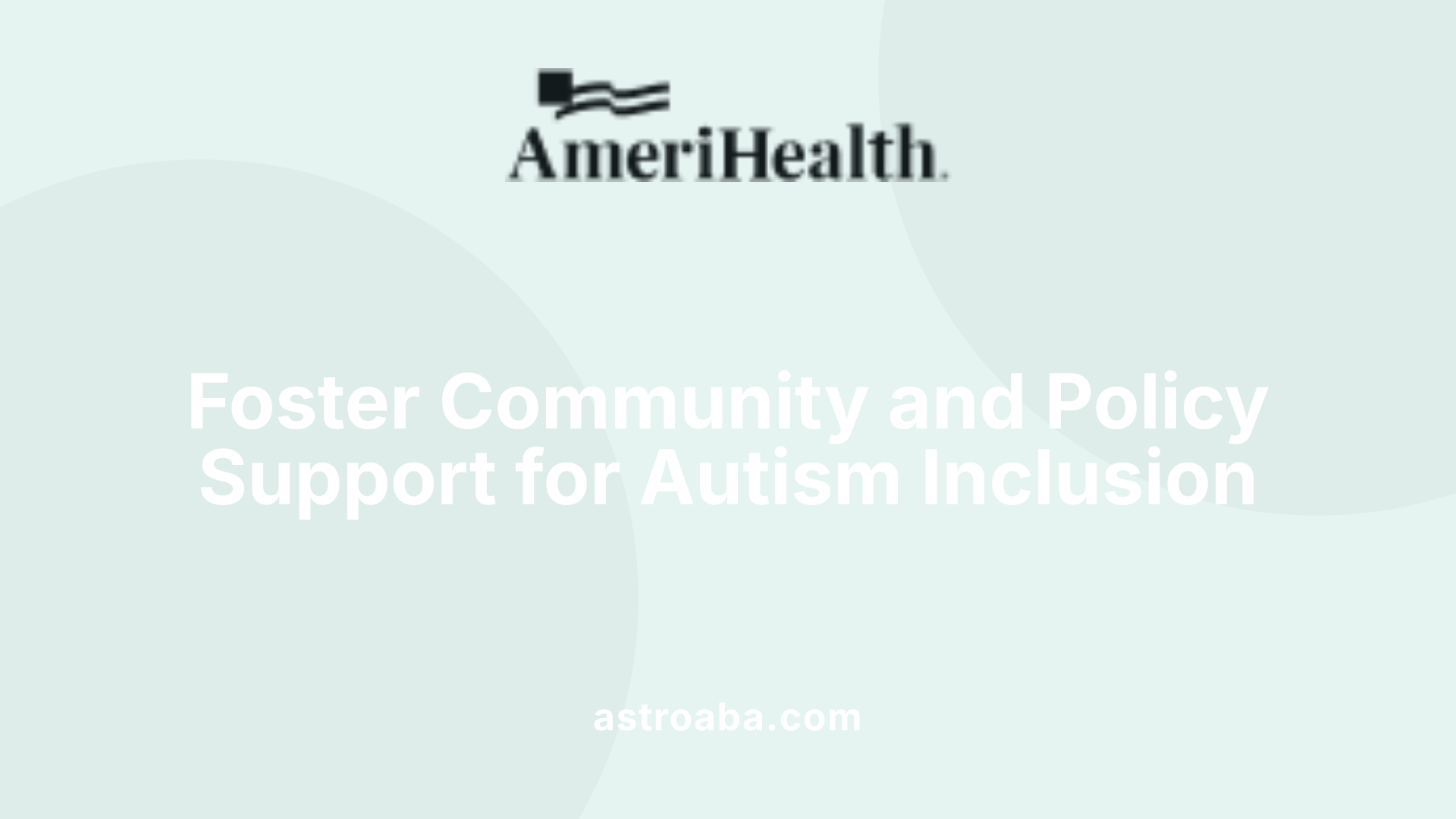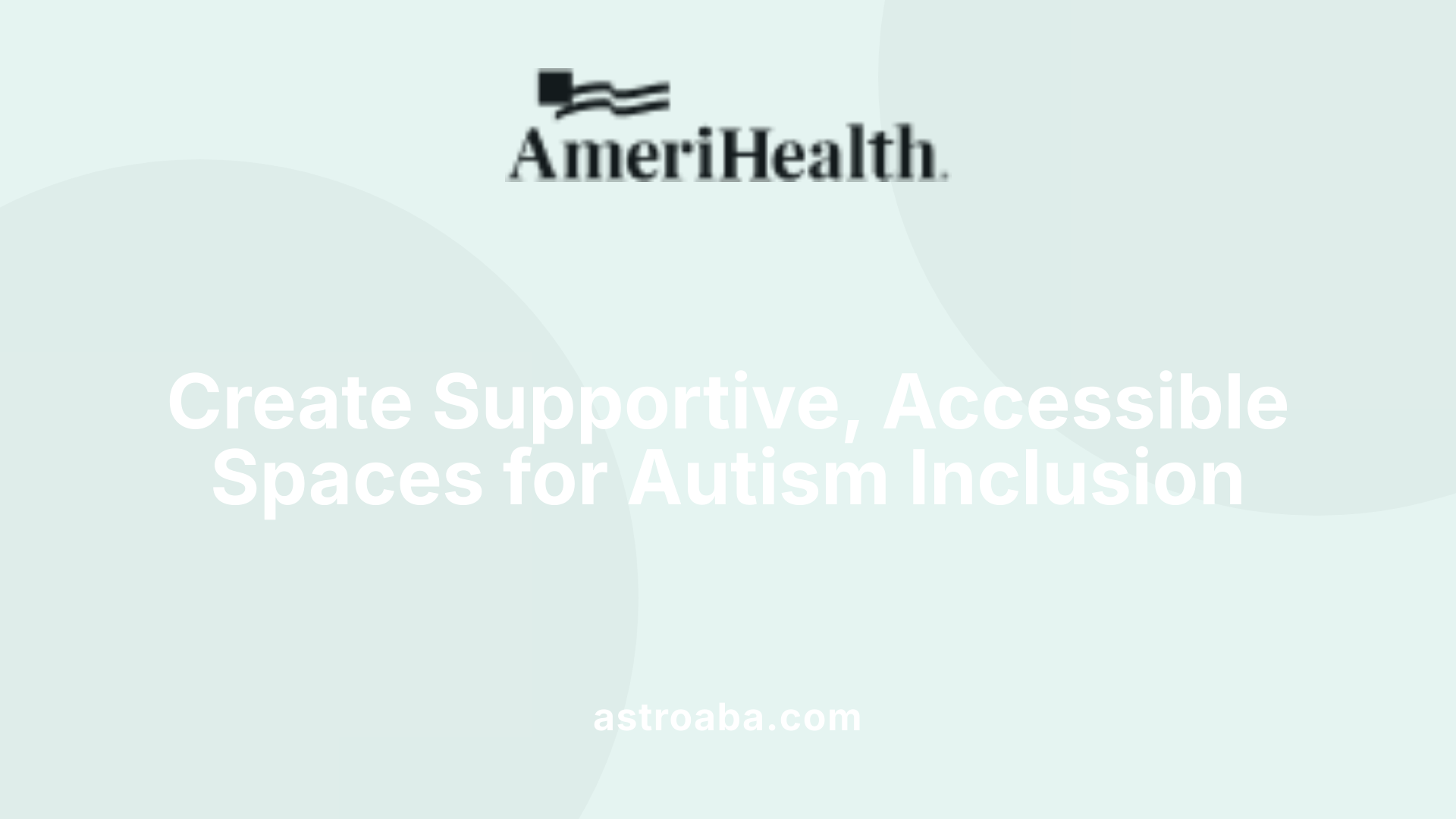How ABA Therapy Can Help with Public Outings and Community Integration
Bridging the Gap: Enhancing Community Life for Children with Autism

Empowering Inclusion Through Behavioral Interventions
Community involvement is vital for children with autism to develop social skills and achieve independence. ABA therapy, grounded in evidence-based principles, plays a central role in equipping children and youth with the skills necessary to navigate public outings and participate fully in community life. This article explores how ABA techniques and community programs work in tandem to promote inclusive participation, ensuring children with autism can enjoy meaningful and safe community experiences.
The Benefits of ABA in Promoting Community Engagement
What are the benefits of ABA therapy in supporting community involvement and social skills development for individuals with autism?
Applied Behavior Analysis (ABA) is an evidence-based approach that significantly enhances the ability of individuals with autism to participate actively and meaningfully in their communities.
One of the primary benefits of ABA is its focus on improving social skills. Children and teens learn to initiate conversations, share experiences, and take turns during interactions, which are crucial for building friendships and social acceptance.
Through targeted teaching strategies, ABA helps develop confidence in individuals with autism. As they master social interactions, their ability to engage with peers and community members improves, fostering a sense of belonging and inclusion.
ABA therapy encourages the transfer of acquired skills across different settings such as parks, schools, and recreational areas. This generalization ensures that children can apply their communication and social skills in real-world situations, leading to greater independence.
Enhancing functional communication is another vital aspect of ABA. Using gestures, sign language, or assistive communication devices, individuals learn to express their needs and desires effectively, reducing frustration and increasing participation.
Moreover, ABA techniques aim to reduce problematic behaviors that can hinder social interaction and community participation. By addressing behaviors such as tantrums or withdrawal, the therapy supports individuals in becoming more adaptable and independent.
Overall, ABA helps create a foundation for successful community engagement. Children and teens develop essential life skills, confidence, and social competence that not only improve their quality of life but also foster acceptance and support within their communities.
| Aspect of Community Engagement | Skills Developed | Supporting Techniques | Additional Benefits |
|---|---|---|---|
| Social Skills | Initiating conversations, sharing, taking turns | Role-playing, social stories | Enhanced friendships, peer acceptance |
| Confidence Building | Peer interaction, self-expression | Reinforcement, positive feedback | Greater independence, motivation to participate |
| Skill Generalization | Navigating different community settings | Community outings, real-world practice | Ease in parks, schools, recreational areas |
| Functional Communication | Using gestures, signs, devices | Visual aids, assistive tech | Reduces frustration, improves understanding |
| Behavior Management | Reducing problematic behaviors | Data collection, behavior modification | Increased safety, sustained participation |
Creating welcoming, accessible environments and supporting social skill development through ABA are essential steps toward inclusive communities where individuals with autism can thrive.
Community programs that integrate ABA principles—such as inclusive recreation, vocational training, and education—further promote meaningful social participation. Public awareness campaigns and policy advocacy also play vital roles in fostering understanding, acceptance, and support for all members.
Together, these efforts help build resilient, inclusive communities that recognize and nurture the diverse abilities of individuals with autism, paving the way for lifelong engagement and personal growth.
Supporting Children in Developing Social Skills and Independence during Community Outings

How does ABA therapy support children with autism in developing social skills and independence during community outings?
Applied Behavior Analysis (ABA) therapy plays a significant role in helping children with autism navigate community outings more confidently and independently. This is achieved through structured, tailored approaches that break down complex social behaviors into manageable steps, making learning achievable and less overwhelming.
One of the core techniques used in ABA is the implementation of social stories. These are customized narratives that prepare children by illustrating expected behaviors in specific community settings, such as grocery stores or parks. Alongside social stories, role-playing exercises simulate real-life situations, enabling children to practice interactions with peers, store clerks, or service providers.
Video modeling is another powerful tool, where children watch videos demonstrating appropriate social responses, then imitate those behaviors in real scenarios. Social scripts, which are written or visual cues outlining verbal and non-verbal responses, help children anticipate and navigate social exchanges effectively.
Reinforcement strategies are central to ABA, encouraging children to engage in positive social behaviors through praise, rewards, or preferred activities. These strategies motivate children to practice social skills repeatedly, fostering confidence and consistency.
Group social skills training sessions create opportunities for peer interaction and teamwork. Such settings help children generalize learned skills, improve their ability to read social cues, and develop friendships.
To maximize success, ABA emphasizes collaboration with parents, teachers, and caregivers. Consistent reinforcement and transfer of skills across different environments facilitate lasting improvements in social interaction and independence.
In summary, ABA therapy provides a comprehensive framework that equips children with autism with the social and emotional tools they need to participate actively and confidently during community outings. This approach not only enhances immediate social skills but also contributes to broader developmental progress and overall quality of life.
Facilitating Social Navigation During Community Events

How does ABA therapy help children and youth with autism navigate social settings during community events?
ABA (Applied Behavior Analysis) therapy plays a vital role in supporting children and youth with autism to effectively navigate social settings during community events. It offers personalized, structured interventions aimed at developing crucial social skills such as initiating interactions, interpreting social cues, and responding appropriately to others.
One of the core methods used in ABA involves reinforcing positive behaviors while gradually teaching new skills through techniques like role-playing, social stories, visual supports, and video modeling. These strategies are engaging and tailored to each child's interests and needs, making learning both effective and enjoyable.
Role-playing activities simulate real-life interactions, helping children practice and understand social norms in a controlled environment. Social stories and visual supports provide clear, predictable frameworks for social expectations, reducing anxiety and confusion. Video modeling demonstrates desired behaviors in dynamic, realistic contexts, aiding children in understanding and replicating appropriate social responses.
To ensure these skills are transferable beyond therapy sessions, ABA emphasizes generalization through group social skills training and natural environment teaching. These approaches enable children to practice social behaviors in settings that closely resemble everyday community environments.
Moreover, ongoing collaboration with caregivers, educators, and community members ensures consistency and reinforcement across various settings. This teamwork helps children apply their skills confidently during community events, fostering social inclusion and independence.
In summary, ABA therapy equips children and youth with autism with essential social tools, enabling them to participate more comfortably and successfully in community activities. By combining tailored interventions with real-world practice and support, ABA facilitates meaningful social engagement, empowering children to build relationships and enjoy community life.
Techniques and Approaches to Promote Inclusion in Community Activities
What techniques does ABA therapy use to promote inclusive participation in community activities for children with autism?
ABA therapy employs various proven techniques to help children with autism participate more fully and comfortably in community settings. Central to these methods are strategies like prompting, reinforcement, modeling, and social skills training. Prompting involves providing hints or cues to encourage desired behaviors, which are gradually faded as the child gains independence.
Reinforcement rewards positive behaviors, motivating children to imitate and practice social interactions. Modeling demonstrates appropriate social behaviors by role models, such as therapists, peers, or family members, encouraging children to replicate these actions. Social skills training focuses explicitly on teaching skills like sharing, taking turns, initiating conversations, and understanding social cues.
These techniques are personalized through detailed assessments and individual treatment plans, ensuring that interventions target each child's specific needs and developmental level. The interventions are also designed to promote the generalization of skills across various environments, including schools, parks, and community events.
ABA often incorporates peer-mediated strategies, encouraging children to practice social interactions with classmates or community peers under supportive supervision. Collaboration with families and community organizations ensures that learned skills are reinforced beyond therapy sessions.
Research supports that sustained ABA interventions lead to notable improvements in social competence and communication. As children develop these skills, they experience less social isolation and greater inclusion in community activities.
Ultimately, ABA focuses on creating accessible, supportive environments that make community participation achievable and rewarding for children with autism. By fostering social intuition alongside practical communication skills, ABA helps children develop the confidence necessary to navigate social settings effectively, significantly enhancing their quality of life.
Strategies to Facilitate Social Participation and Independence in Community Settings
What approaches are used in ABA therapy to facilitate social participation and independence in community settings?
ABA therapy incorporates several effective, evidence-based approaches tailored to improving social involvement and independence among individuals with autism. These techniques focus on developing skills that enable active engagement in everyday community activities, from shopping to socializing.
One fundamental approach is task analysis. This method involves breaking down complex behaviors—such as crossing a street or ordering food—into smaller, manageable steps. By clearly defining each component, children can learn each part systematically, increasing efficiency and confidence.
Prompting and prompt fading are also widely used. Prompting involves providing hints or assistance when a child is learning a new skill, such as guiding their hand while using a wheelchair or encouraging eye contact during a conversation. Over time, prompts are gradually withdrawn (faded) to promote independent performance.
Positive reinforcement is central to ABA techniques. When children successfully perform a skill or exhibit desired social behaviors—like greeting a peer—they receive rewards, such as praise, tokens, or other preferred items. This encourages repeated behaviors and builds motivation.
Natural environment teaching (NET), also called naturalistic teaching, emphasizes teaching skills within typical settings and routines. For instance, teaching a child to ask for help during a grocery store visit or to take turns in a community game makes learning directly relevant to real-life situations.
Embedded teaching methods, such as SWAT Support (Supportive, Well-Integrated, and Targeted), integrate intervention strategies into natural settings, providing on-the-spot assistance that prompts the child towards appropriate social and functional behaviors. These methods help children generalize skills across various community contexts.
Caregivers, teachers, and community staff are trained to model behaviors, reinforce positive actions, and establish consistent routines. This support helps children develop independence in activities like shopping, using public transportation, volunteering, or employment tasks.
Continual progress monitoring through assessments ensures that each child’s intervention plan remains personalized and efficient. Adjustments are made based on observable improvements, ensuring continuous growth towards community participation.
Overall, these strategies aim to equip individuals with autism with the necessary skills to navigate community environments confidently, ultimately promoting autonomy and full integration into society.
The Role of Community and Policy in Supporting Autism Inclusion

How do autism awareness activities promote inclusion?
Autism awareness activities serve as vital tools to foster understanding and acceptance of individuals with autism spectrum disorder (ASD). These activities include sensory-friendly events, social scenario role-playing, group games, and art projects designed to support children with autism in developing crucial social, communication, and sensory processing skills.
Within ABA therapy centers, implementing these activities enhances public understanding of autism, which in turn encourages integration and community participation. For example, autism day events featuring interactive activities and educational workshops help break down stereotypes and foster empathy within the wider community.
Community engagement is further strengthened by involving local schools, families, and community members through awareness initiatives. These efforts build a supportive network that values diversity and promotes the inclusion of children with autism in everyday activities.
Creating environments that are sensory-friendly and accessible is also essential. Spaces such as sensory corners at home and in community centers provide safe, stimulating areas where children can regulate sensory input, reducing anxiety during outings. Visual aids like social stories and schedules prepare children for social situations, boosting their confidence and independence.
Assistive communication strategies, including technology, gestures, and visual aids, enable nonverbal children to express their needs effectively during community activities. Moreover, community centers and social skills groups offer structured settings for practicing interactions, fostering greater community integration.
Gradual exposure to public spaces—using tools like noise-canceling headphones, visual schedules, and social stories—helps children overcome overwhelm, promoting greater independence in outings. These experiences, supported by trained professionals and tailored interventions, are integral to supporting children with autism in navigating their environments comfortably.
How do collaborations among families, organizations, and policymakers further promote inclusion?
Successful autism inclusion relies heavily on partnerships among families, community organizations, schools, and policymakers. These collaborations ensure that effective programs and policies are in place, fostering an environment where individuals with autism can thrive.
Families play a central role by sharing insights on individual needs and advocating for appropriate services. Support networks formed through parent groups and community organizations provide vital resources, guidance, and emotional support.
Organizations and community centers implement programs like social skills classes, vocational training, and employment support to prepare individuals with autism for independent living and community participation. These initiatives often incorporate ABA principles, developmental approaches like speech and occupational therapy, and social-relational treatments.
Policymakers contribute by enacting inclusive policies such as funding for special programs, anti-discrimination laws, and inclusive education mandates. Promoting accessible community spaces, employment opportunities, and accommodations in workplaces support individuals with autism to achieve full societal participation.
Efforts to integrate autism-friendly modifications into public infrastructure—sensory-friendly rooms, clear signage, quiet zones—reduce barriers and make community spaces more navigable.
Table 1 summarizes how different stakeholders contribute to autism inclusion:
| Stakeholder | Contributions | Examples |
|---|---|---|
| Families | Advocacy, ongoing support | Parent groups, personalized routines |
| Community Organizations | Program implementation, social skills training | Social groups, vocational programs |
| Schools | Inclusive education, behavioral support | Special needs classrooms, staff training |
| Policymakers | Legislation, funding, infrastructure | Anti-discrimination laws, sensory space grants |
By working together, these collaborations strengthen community support, enhance resource availability, and foster a culture of inclusion, ensuring that individuals with autism can access opportunities for growth, learning, and belonging.
Building Support Networks and Inclusive Policies

Creating Safe and Sensory-Friendly Spaces
Designating accessible, sensory-friendly spaces within community areas, such as sensory corners or quiet zones, helps children and adults with autism regulate their sensory input. These spaces provide a calming environment away from overwhelming stimuli and can be implemented in community centers, schools, and public venues. Easy-to-understand signage and clear pathways make these areas welcoming and easy to navigate.
Organizing Inclusive Events with Accommodations
Community events like social workshops, sports days, and cultural festivals can foster inclusivity by incorporating autism-friendly features. Activities tailored to sensory sensitivities—such as low lighting, reduced noise, and sensory breaks—allow children and adults with autism to participate confidently. Additionally, workshops that educate attendees about autism promote understanding and empathy, helping break down stereotypes.
Community Policy Advocacy to Promote Inclusive Environments
Advocating for policies that support autism inclusion is vital. This includes pushing for funding for sensory-friendly modifications, anti-discrimination legislation, and inclusive education programs. Policymakers can help remove barriers by ensuring equal access to public services, educational opportunities, and community activities. Engagement through public consultations and partnerships with autism organizations can strengthen these efforts.
Employment Opportunities and Workplace Accommodations
Creating job opportunities for individuals with autism involves providing necessary workplace adjustments and targeted training. Employers can facilitate accessibility through flexible schedules, sensory-friendly workspaces, and clear communication tools. Promoting awareness and understanding within workplaces prepares colleagues to support colleagues with autism, fostering an inclusive environment where employees can thrive.
| Initiative Type | Example Actions | Impact |
|---|---|---|
| Sensory Spaces | Quiet zones, sensory corners | Reduce sensory overload, increase comfort |
| Inclusive Events | Autism-friendly fairs, workshops | Promote participation, break stereotypes |
| Policy Advocacy | Funding, anti-discrimination laws | Facilitate access, prevent discrimination |
| Employment | Workplace accommodations, training | Increase employment, independence |
Developing communities that actively support autism through strategic policies and inclusive practices enhances overall well-being. Building supportive networks among organizations, families, and individuals creates a resilient environment where everyone can participate fully in community life.
The Critical Need for Public Awareness and Inclusive Policies

How do educational workshops, awareness campaigns, and training programs for professionals help promote autism understanding?
Educational workshops and awareness campaigns serve as vital platforms for spreading accurate information about autism spectrum disorder (ASD). These initiatives can dispel common misconceptions and stereotypes, fostering a more accepting and knowledgeable community. Training programs directed at teachers, healthcare providers, and other professionals equip them with the skills to support individuals with autism effectively. Such training emphasizes understanding sensory needs, communication styles, and behavioral strategies, which are crucial in creating inclusive environments.
Community-based awareness campaigns often incorporate stories from individuals with autism and their families, highlighting the diversity of experiences and capabilities. This humanizes autism and underscores the importance of acceptance and support. When community members, educators, and service providers are better informed, they can implement inclusive practices that benefit children and adults with autism across various settings.
In what ways can reducing stigma through understanding and empathy influence community integration?
Reducing stigma is essential for cultivating an inclusive atmosphere where individuals with autism can thrive. When communities foster understanding and empathy, misconceptions diminish, leading to increased acceptance. This shift encourages social participation and helps break down barriers such as social exclusion or discrimination.
Initiatives like autism awareness events, inclusive social activities, and parent-led peer groups promote direct interactions and conversations. These experiences allow community members to see beyond stereotypes and appreciate each individual’s unique strengths. Over time, increased understanding and empathy promote policy changes and community practices that support full integration, enabling people with autism to access education, employment, and social opportunities.
How can creating policies support comprehensive community integration?
Effective policies are foundational to embedding inclusivity into the fabric of community life. Policies that support autism awareness via funding for educational programs, public campaigns, and accessible infrastructure ensure sustained efforts towards understanding.
Inclusive policies also involve creating accessible environments through modifications like sensory-friendly spaces, quiet zones, and clear signage in public areas, reducing sensory overload and navigational challenges. Moreover, legislation promoting employment rights, anti-discrimination laws, and funding for community programs help ensure meaningful participation.
Supporting life skills training, vocational programs, and community-based learning initiatives prepares individuals with autism for independent living and employment, fostering economic participation. When policymakers collaborate with autism advocates, educators, and healthcare providers, they develop comprehensive strategies that promote holistic community integration.
| Initiative Type | Specific Actions | Intended Impact |
|---|---|---|
| Education & Training | Workshops, professional development, community seminars | Increased awareness, better support skills |
| Infrastructure Modifications | Sensory rooms, clear signage, quiet zones | Reduced sensory overload, better accessibility |
| Policy & Legislation | Funding, anti-discrimination laws, employment support | Equal opportunities, social participation |
| Community Engagement | Inclusive events, peer support groups | Empathy building, relationship development |
| Life Skills & Vocational Support | Job training, independent living programs | Increased independence, community contribution |
Charting a Path Toward Full Community Participation
By leveraging evidence-based ABA techniques and fostering inclusive community environments, children and youth with autism can achieve greater independence and social participation. Promoting public awareness through targeted campaigns, inclusive policies, and participatory events creates a supportive atmosphere that benefits everyone. Continued collaboration among families, professionals, and policymakers is essential to breaking down barriers and building truly inclusive communities where every individual has the opportunity to thrive.
References
- Autism Awareness Activities for ABA Therapy Centers - CMG
- Impactful Ways to Improve Lives of Kids with Autism - Move Up ABA
- ABA Therapy for Teens: Building Independence - Therapyland
- Treatment and Intervention for Autism Spectrum Disorder - CDC
- Applied Behavior Analysis in Children and Youth with Autism ...
- Summer Success: How ABA Therapy Can Improve Social Skills for ...
- 7 Ways to Build Inclusive Communities for Autism - Perfect Pair ABA
Recent articles

The Role of Prompting and Fading in ABA Therapy Programs
Enhancing Autism Interventions Through Systematic Support Reduction

The Role of ABA Therapy in Supporting Community Participation
Enhancing Lives Through Community-Focused ABA Interventions

The Role of ABA Therapy in Encouraging Initiative and Motivation
Unlocking Potential: How ABA Empowers Children to Take Initiative

How ABA Therapy Helps Children Develop Initiation and Motivation
Unlocking Potential: The Power of ABA in Fostering Child Independence

How ABA Therapy Encourages Participation in Cooperative Group Activities
Fostering Social Skills Through ABA Interventions

How ABA Therapy Supports Independent Task Initiation in Children
Empowering Children to Begin with Confidence

How ABA Therapy Helps Children Build Resilience in Challenging Situations
Building Emotional Strength Through ABA Therapy

The Impact of ABA Therapy on Reducing Anxiety in Social Settings
Transforming Social Experiences: How ABA Therapy Eases Autism-Related Anxiety

Strategies for Teaching Self-Monitoring Through ABA
Empowering Independence: Techniques to Foster Self-Monitoring with ABA

The Benefits of Combining ABA with Speech and Language Therapy
Integrating Treatment Approaches to Maximize Developmental Progress

Strategies for Teaching Cooperative Problem-Solving Through ABA
Enhancing Collaborative Skills with ABA: Proven Strategies and Techniques

How ABA Therapy Encourages Independent Participation in Daily Tasks
Empowering Autonomy: How ABA Therapy Builds Independence in Daily Life

Creating an Effective Learning Environment at Home for ABA Therapy
Building a Supportive Home Environment for ABA Success

How ABA Therapy Encourages Following Safety Rules at Home and School
Empowering Children with Autism to Follow Essential Safety Rules

How ABA Therapy Encourages Communication Using Gestures and Signs
Enhancing Social Skills with Targeted Gesture Teaching

Common ABA Therapy Techniques for Reducing Aggression
Innovative Strategies in ABA to Minimize Aggressive Behaviors

How ABA Therapy Encourages Communication Using Gestures and Signs
Unlocking the Power of Gestures and Signs in Autism Therapy

How ABA Therapy Encourages Appropriate Social Greetings
Enhancing Social Skills Through Evidence-Based Interventions

Addressing Social Anxiety Using ABA-Based Techniques
Harnessing ABA to Alleviate Social Anxiety

Famous Politicians With Autism
Celebrating Neurodiversity: Insights into Autism and Notable Figures

How ABA Therapy Can Help with Anxiety in Children with Autism
Unlocking Emotional Well-Being: The Power of ABA in Managing Autism-Related Anxiety

The Impact of ABA Therapy on School Success
Enhancing Educational Outcomes with Systematic Interventions

The Importance of Social Stories in ABA Therapy
Harnessing Social Stories to Enhance Social Skills in Autism Interventions

Mild Autism
Understanding the Nuances of Mild Autism

What Are Functional Behavior Assessments (FBA) in ABA Therapy?
Unlocking the Secrets Behind Behavior: The Power of FBAs in ABA

Early Signs Of Autism In Babies And Kids
Recognizing Early Indicators to Support Developmental Health

How to Find Funding for ABA Therapy Services
Unlocking Funding Opportunities for Autism Treatments

How to Help a Child with Autism Transition to ABA Therapy
Supporting Children Through Transition Phases in ABA Therapy

Do Autistic People Get Injured More?
Examining Injury Risks in Individuals with Autism Spectrum Disorder

How ABA Therapy Can Help with Executive Functioning Challenges
Unlocking Skills: The Impact of ABA on Executive Functioning in Autism

What is the Premack Principle in ABA Therapy?
Unlocking Motivation: The Power of the Premack Principle in ABA Therapy

Low-Functioning Autism
Understanding the Challenges and Supports for Low-Functioning Autism

Low-Functioning Autism
Understanding the Challenges and Supports for Low-Functioning Autism

How ABA Therapy Can Help with Playdates and Social Events
Unlocking Social Success: How ABA Therapy Facilitates Playdates and Community Engagement

How ABA Therapy Can Address Impulse Control Issues
Mastering Behavioral Growth: The Power of ABA in Impulse Control

Book, Movie, and TV Characters on the Autism Spectrum
Enhancing Understanding Through Fictional Portrayals

Book, Movie, and TV Characters on the Autism Spectrum
Enhancing Understanding Through Fictional Portrayals

The Role of Visual Supports in ABA Therapy
Enhancing Autism Interventions with Visual Supports

What Is Pervasive Developmental Disorder
Understanding the Spectrum of Developmental Challenges

How ABA Therapy Helps with Emotional Regulation
Empowering Emotional Resilience in Children with Autism

What is Task Analysis in ABA Therapy?
Unveiling the Foundations of Task Analysis in ABA Therapy

How ABA Therapy Can Improve Play Skills
Unlocking Growth: The Power of ABA in Enhancing Play Skills

Air Pollution and Autism
Unveiling the Environmental Impact on Developing Minds

How ABA Therapy Can Help with Bullying Prevention
Building Respect and Resilience Through ABA

How ABA Therapy Can Be Used to Teach Problem-Solving Strategies
Empowering Individuals with Autism Through Targeted Problem-Solving Skills

Can Autistic People Work?
Unlocking Potential: The Realities of Employment for Autistic Individuals

How ABA Therapy Can Help with Homework and Academics
Empowering Academic Success with ABA Therapy

Common Myths About ABA Therapy Debunked
Unmasking Autism Treatment: The Truth About ABA Therapy

Does Aluminum Cause Autism?
Unraveling the Link: Aluminum and Autism Spectrum Disorder

How ABA Therapy Can Support Emotional Expression and Understanding
Unlocking Emotional Growth in Autism Through ABA Therapy

The Role of ABA Therapy in Helping Children Learn Road Safety
Empowering Safe Journeys: How ABA Therapy Fosters Road Safety Skills in Children

The Role of Group ABA Therapy in Social Development
Enhancing Social Skills Through Collective Strategies

What Is Autistic Burnout?
Understanding the Hidden Struggle of Autistic Burnout

How Do You Get An Autistic Child To Keep Their Shoes On?
Mastering Comfort and Compliance with Shoes for Autistic Children

The Role of ABA Therapy in Addressing Food Aversions and Picky Eating
Transforming Mealtimes: How ABA Therapy Supports Children with Autism

How ABA Therapy Can Assist in Reducing Perfectionism and Anxiety
Harnessing Behavioral Science to Ease Perfectionism and Anxiety

What Is Defeat Autism Now?
Unveiling the Roots and Realities of the DAN Movement

How ABA Therapy Can Help Children Develop Conflict Resolution Skills
Building Bridges: Empowering Children with Conflict Resolution Skills through ABA

OCD vs. Autism
Unraveling the Complex Relationship Between OCD and Autism

Temper Tantrums A Sign Of Autism
Understanding the Complex Relationship Between Temper Tantrums and Autism Spectrum Disorder

How to Pass the BCBA Exam
Your Ultimate Guide to Success in the BCBA Exam

Autism and Addiction's Close Connection
Unraveling the Complex Interplay Between Autism and Substance Use

Autism Facial Expressions
Decoding Emotions: The Complex World of Facial Expressions in Autism

How ABA Therapy Can Help Reduce Anxiety Around Doctor and Dentist Visits
Transforming Medical Experiences for Children with Autism

How ABA Therapy Can Help with Navigating Social Media Responsibly
Empowering Safe Online Engagement for Children with Autism through ABA

How to Choose an Autism Charity
Navigating the Spectrum of Support: A Guide to Selecting the Right Autism Charity

What is Precision Teaching in ABA Therapy?
Harnessing Data-Driven Strategies for Skill Mastery

Autism and Obesity
Understanding the Overlap: Autism and the Rising Concern of Obesity

Individualized Education Programs (IEPs) for Autism
Supporting Success: A Comprehensive Guide to IEPs for Children with Autism

How to Integrate ABA Therapy into Everyday Routines
Transforming Daily Life with ABA Strategies

What is Shaping in ABA Therapy?
Understanding the Core of Behavior Shaping in Autism Interventions

Autism vs. ADHD
Understanding the Distinction and Overlap of Neurodevelopmental Disorders

Is RBT Certification Worth It?
Unveiling the Value of RBT Certification in the Field of ABA

How Negative Reinforcement Works in ABA Therapy
Unlocking the Power of Negative Reinforcement in Behavioral Therapy

How to Advocate for ABA Therapy Services in Schools
Navigating Advocacy for School-Based ABA Therapy

How ABA Therapy Can Address Impulsivity in Children
Transforming Child Behavior: The Power of ABA Therapy Against Impulsivity

Understanding the Different Types of ABA Therapy Programs
Exploring the Spectrum of ABA Therapy Approaches

How ABA Therapy Can Address Regression in Autism
Understanding Regressive Autism and the Role of ABA Therapy

High Functioning Autism And Anger
Understanding Emotional Challenges in High-Functioning Autism

Autism and Puberty
Understanding Puberty in Autistic Youth: Challenges and Support Strategies

Challenging Autism Behavior Problems
Navigating the Complex Landscape of Autism-Related Behavioral Challenges

How ABA Therapy Can Help with Sleep Problems
Transforming Bedtime Routines with Evidence-Based Approaches

How ABA Therapy Can Help Improve Cooperation and Compliance
Fostering Respectful Engagement: The Role of ABA in Enhancing Cooperation and Compliance

Eating Disorders And Autism
Unraveling the Complex Relationship Between Autism and Eating Disorders

How Schedules of Reinforcement Work in ABA Therapy
Mastering Reinforcement Patterns to Foster Behavior Change

How to Incorporate ABA Therapy into a Homeschooling Program
Transforming Homeschooling with Evidence-Based Strategies

What Are the Most Common Misconceptions About ABA Therapy?
Unveiling the Truth Behind ABA Therapy: Myths vs. Facts

What is Demand Fading in ABA Therapy?
Demystifying Demand Fading in ABA Therapy

What Are ABA Assessments and How Do They Work?
Understanding the Foundations of ABA Assessments

What is an AAC Device for Autism?
Unlocking Communication: The Power of AAC Devices for Autism

How ABA Therapy Can Help Children Understand and Express Emotions
Enhancing Emotional Understanding Through Evidence-Based Interventions

How To Prevent Autism
Emerging Strategies to Reduce Autism Risk in Children

How ABA Therapy Can Improve Verbal and Nonverbal Communication
Unlocking Communication: The Power of ABA Therapy for Children with Autism

Natural Environment Teaching (NET): How It Helps with Skill Generalization
Unlocking Practical Learning in Natural Settings

What Is Play Therapy For Autism?
Unlocking the Potential of Play in Autism Therapy

How ABA Therapy Can Improve Fine and Gross Motor Skills
Enhancing Movement and Independence Through ABA Strategies

Calming Strategies For Kids With Autism
Understanding and Supporting Calmness in Children with Autism

Autism Evaluation
Comprehensive Insights into Autism Assessment and Diagnosis

How to Support Your Child's ABA Therapy at Home
Empowering Your Child’s Development at Home with ABA Support

Autism Prevalence Increases in Arizona
Rising Autism Rates Signal Changing Landscape in Arizona

